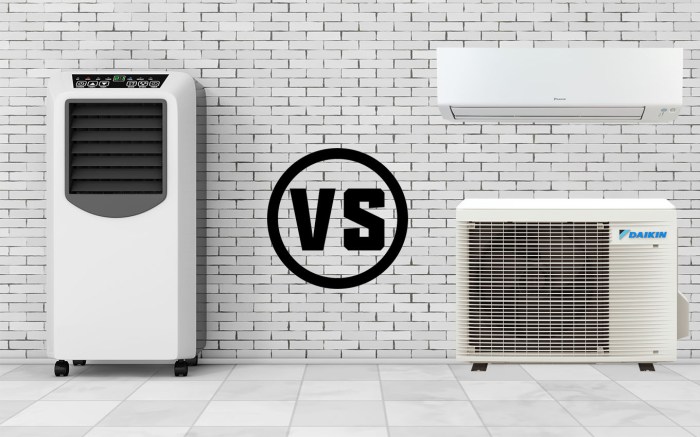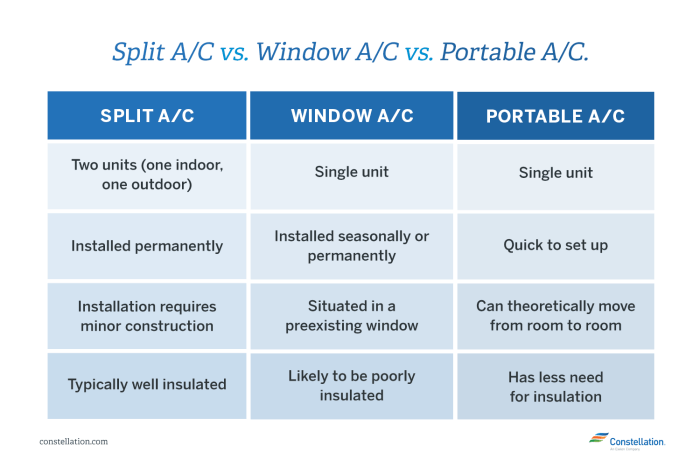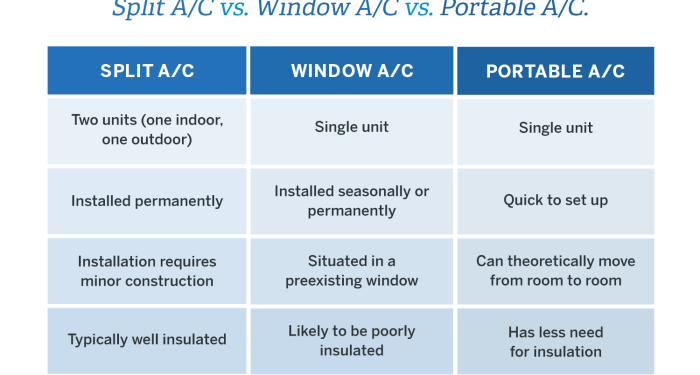Exploring the choice between Portable ACs and Split Units, this introduction sets the stage for an informative comparison that will help you decide which option suits your needs best.
Providing a detailed look into the key differences and considerations between these two types of air conditioning units, this discussion aims to equip you with the knowledge necessary for making an informed decision.
Introduction to Portable AC and Split Unit

Portable AC and Split Unit are two common types of air conditioning systems used in homes and offices. Each has its own advantages and drawbacks, making it essential to understand their differences to choose the right one for your needs.
Definition and Basic Differences
A Portable AC is a standalone unit that can be moved from room to room, requiring no permanent installation. On the other hand, a Split Unit consists of two main components - an indoor unit (evaporator) and an outdoor unit (condenser) - connected by refrigerant lines.
- Portable AC:
- Easy to install and move around
- No need for professional installation
- Suitable for small spaces
- Split Unit:
- Provides better cooling efficiency
- Less noisy compared to Portable AC
- Requires professional installation
Benefits and Drawbacks
- Portable AC:
- Benefits:
- Flexibility to cool different rooms
- No permanent installation required
- Easy to store when not in use
- Drawbacks:
- Less cooling power compared to Split Units
- Noisy operation
- May require frequent emptying of condensate water
- Benefits:
- Split Unit:
- Benefits:
- Efficient cooling for larger spaces
- Quiet operation
- Improved air quality with better filtration
- Drawbacks:
- Requires professional installation
- Higher initial cost
- Not easily movable between rooms
- Benefits:
Cost Comparison
When it comes to deciding between a Portable AC and a Split Unit, the cost factor plays a significant role. Let's break down the initial and long-term costs to see which option might be more cost-effective for you.
Initial Cost
- Portable AC: Portable air conditioners are generally more affordable upfront compared to split units. You can find a decent portable AC unit for around $300 to $800, depending on the brand and features.
- Split Unit: On the other hand, split air conditioning systems tend to be more expensive initially. A basic split unit can cost anywhere from $1,000 to $4,000 or more, depending on the size and brand.
Long-Term Cost Implications
- Maintenance:Portable ACs usually require less maintenance compared to split units. They are easier to clean and the filters are more accessible. Split units might need professional maintenance, which can add to the long-term costs.
- Energy Efficiency:Split units are generally more energy-efficient than portable ACs. This means that while the initial cost might be higher, you could save on electricity bills in the long run with a split unit.
Cost-Effectiveness
- When considering cost-effectiveness, it's important to factor in both the initial cost and the long-term expenses. While portable ACs are cheaper upfront, split units might prove to be more cost-effective in the long run due to their energy efficiency and potential savings on electricity bills.
- Ultimately, the choice between a portable AC and a split unit will depend on your budget, cooling needs, and long-term cost considerations.
Installation Process

When it comes to installing air conditioning units, both portable ACs and split units have their own unique processes. Let's take a closer look at the installation steps for each type of unit.
Portable AC Units
Installing a portable AC unit is relatively simple and does not require any permanent changes to your home. Here are the general steps involved in setting up a portable AC:
- Place the unit near a window or sliding door for proper ventilation.
- Extend the exhaust hose from the back of the unit to the outside through the window or door.
- Plug in the unit to a power source and turn it on.
- Adjust the settings to your desired temperature and fan speed.
Note: Make sure to regularly clean the filters and exhaust hose to maintain optimal performance.
Split Units
Installing a split unit air conditioner is more complex and usually requires professional assistance. Here are the typical steps involved in the installation process for a split unit AC:
- Mount the indoor unit on a wall inside the room you want to cool.
- Install the outdoor unit on a stable surface outside the building.
- Connect the indoor and outdoor units with refrigerant lines and electrical wiring.
- Test the unit to ensure it is functioning properly.
Note: Split units may require drilling holes in walls for the refrigerant lines and wiring, which can be a challenging aspect of the installation process.
Overall, the installation process for portable AC units is simpler and more DIY-friendly, while split units require professional installation due to their more complex setup and potential structural modifications. Make sure to consider your comfort level with DIY projects and the specific requirements of your living space when choosing between these two types of air conditioning units.
Cooling Capacity and Efficiency
When it comes to choosing between a Portable AC and a Split Unit, understanding the cooling capacity and efficiency of both types of air conditioners is crucial in making an informed decision.
Cooling Capacity Comparison
Portable ACs and Split Units vary in terms of cooling capacity. Portable ACs are typically designed to cool smaller spaces, such as a single room or a small apartment. On the other hand, Split Units have a higher cooling capacity and are more suitable for larger areas, such as multiple rooms or an entire house.
Energy Efficiency Ratings
Both Portable ACs and Split Units come with energy efficiency ratings to indicate their ability to cool a space efficiently without consuming excessive energy. Split Units are generally more energy-efficient compared to Portable ACs, as they are designed to cool larger areas with less power consumption.
Effectiveness in Cooling Larger Spaces
When it comes to cooling larger spaces, Split Units are more effective than Portable ACs. Split Units can distribute cool air more evenly throughout a room or multiple rooms, making them a better choice for larger areas. Portable ACs may struggle to cool larger spaces efficiently, especially if the area exceeds their cooling capacity.
Mobility and Space Considerations
When it comes to choosing between portable AC units and split units, factors like mobility and space considerations play a crucial role in making the right decision for your living space.
Portability of Portable AC Units
Portable AC units are designed to be easily moved from one room to another, providing flexibility in cooling different areas of your home. Their compact size and wheels make them convenient to transport, offering a portable cooling solution that can adapt to your changing needs.
Space Requirements for Installing Split Units
On the other hand, split units require professional installation, with the indoor unit mounted on the wall and the outdoor unit placed outside. This installation process can impact the aesthetics of your room, as the indoor unit may not blend seamlessly with your decor.
Additionally, split units take up permanent space on your wall, limiting flexibility in rearranging furniture or room layout.
Suitability for Different Living Spaces
Portable AC units are ideal for renters or those who frequently move homes, as they can be easily transported without the need for complex installation. They are also a great option for smaller living spaces where a permanent split unit installation may not be feasible.
On the other hand, split units are better suited for homeowners looking for a more permanent cooling solution with higher cooling capacity and efficiency.
Noise Levels and Maintenance
When it comes to choosing between a Portable AC and a Split Unit, noise levels and maintenance are important factors to consider for your comfort and the longevity of the appliance.
Noise Levels
- Portable ACs tend to be noisier during operation compared to Split Units. The noise level can range from 50 to 60 decibels, which is equivalent to a normal conversation.
- Split Units, on the other hand, are quieter as the compressor, which is the main source of noise, is located outside the room. This results in noise levels as low as 25 to 40 decibels, similar to a whisper or a quiet library.
Maintenance Tips for Portable AC Units
- Regularly clean or replace the air filter to ensure proper airflow and efficiency.
- Keep the unit's exhaust hose and vents clean and free from obstructions to prevent overheating.
- Check for any leaks or water accumulation and promptly address any issues to prevent mold growth.
- Store the unit properly when not in use, following the manufacturer's guidelines to prolong its lifespan.
Maintenance Requirements for Split Units
- Regular professional maintenance is recommended for Split Units to check refrigerant levels, clean coils, and ensure optimal performance.
- Keep the outdoor unit free from debris and vegetation to maintain proper airflow and prevent compressor damage.
- Inspect the indoor unit for any leaks or water accumulation and address any issues promptly.
- Follow the manufacturer's guidelines for maintenance schedules and procedures to extend the lifespan of the Split Unit.
Environmental Impact
Portable air conditioners and split units have different environmental impacts based on their refrigerants, energy consumption, and overall sustainability features.
Eco-friendliness of Portable ACs
Portable air conditioners typically use refrigerants like R-410A, which have lower ozone depletion potential compared to older refrigerants like R-22. This makes them more environmentally friendly in terms of reducing harm to the ozone layer. Additionally, portable ACs are designed to be energy-efficient, helping to lower overall energy consumption and decrease greenhouse gas emissions.
Environmental Impact of Split Units
Split units, on the other hand, often use refrigerants with higher global warming potentials, such as R-22 or R-410A. While newer models are transitioning to more eco-friendly refrigerants like R-32, the overall impact on the environment can still be significant.
Split units also require more complex installation and maintenance processes, which can contribute to their carbon footprint.
Sustainability Features Comparison
When comparing the sustainability features of portable ACs versus split units, portable units have the advantage of being more flexible and easy to install, reducing the overall environmental impact of the cooling system. Additionally, their mobility allows for targeted cooling, which can lead to more efficient energy use.
Split units, while effective at cooling larger spaces, may not be as energy-efficient and can have a higher environmental impact due to their installation requirements and refrigerant usage.
Concluding Remarks
In conclusion, weighing the pros and cons of Portable ACs and Split Units can lead to a better understanding of which one aligns with your preferences and requirements. By considering factors such as cost, installation, cooling capacity, mobility, maintenance, and environmental impact, you can make a well-informed choice that enhances your comfort and efficiency.
Quick FAQs
Which type of unit is easier to install, Portable AC or Split Unit?
Portable AC units are generally easier to install as they require minimal setup compared to Split Units, which often involve more complex installation procedures.
Are Portable ACs more cost-effective than Split Units in the long run?
While Portable ACs may have lower initial costs, Split Units tend to be more energy-efficient, which can result in cost savings over time, especially in terms of electricity bills.
Do Split Units require more maintenance compared to Portable ACs?
Split Units typically require more maintenance due to their complex setup and components, whereas Portable ACs are relatively easier to maintain with regular cleaning and filter replacements.
Which type of unit is more environmentally friendly, Portable AC or Split Unit?
Portable ACs are generally considered more eco-friendly due to their smaller size and lower energy consumption, while Split Units may have a higher environmental impact depending on the refrigerants used and energy efficiency.




